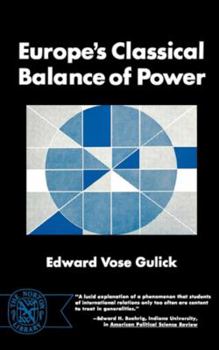Europe's Classical Balance of Power: A Case History of the Theory and Practice of One of the Great Concepts of European Statecraft
Select Format
Select Condition 
Book Overview
What was the origin of the idea of the balance of power? How did European leaders apply its principles in actual practice? Widespread as the term "balance of power" has been, and vital as its principles have been in European statecraft, nevertheless study of its theory and practice has often been neglected by historians. A more complete understanding of the concept is arrived at in Edward Vose Gulick's well-knit examination of the two questions posed above. Throughout the book, the events of history and the diplomatic struggle as played out by statesmen are related to balance-of-power theory as conceived by political scientists. Europe's Classical Balance of Power brings into the spotlight of scholarly attention an idea that has demonstrated great vitality in times gone by, that has worked behind the scenes in the conclaves of power, and that, under another name, has survived to influence twentieth-century diplomacy.
Format:Paperback
Language:English
ISBN:0393004139
ISBN13:9780393004137
Release Date:May 1967
Publisher:W. W. Norton & Company
Length:356 Pages
Weight:0.73 lbs.
Dimensions:0.9" x 5.1" x 8.1"
Customer Reviews
1 rating
Balance of Power and the Congress of Vienna
Published by Thriftbooks.com User , 23 years ago
Gulick's book is a perceptive discussion of the principles and use of the balance of power. Gulick starts by analyzing the assumptions, goals and means of the balance of power. Then he analyzed the Congress of Vienna which reset the balance of power after it was destroyed by the French revolution and Napoleon.Gulick assumes the existence of a system of states of similar size, using permanent ambassadors to observe the states continuously, and a way of measuring the strength of a state. He explains that the balance of power is created to maintain the existence of the states system. Then Gulick defines the means to these aims. He mentions surveillance, alliances, coalitions, the ability to switch alliances quickly, and the determination to either destroy an enemy completely, or rebuild him to maintain the balance of power. Napoleons military success destroyed the balance of power in Europe. Gulick describes the attempts to regain that balance. He begins with an alliance of Austria, Prussia and Russia to oppose Napoleon. Then Castlereagh arrived from Britain to create a grand coalition for several goals. The first goal was to defeat Napoleon, The second goal was to rearrange the borders, that Napoleon had changed, which would strengthen the balance of power. The last goal was to create a permanent diplomatic structure to maintain peace. Castlereagh encountered distrust among the allies, especially between Austria and Russia, which made his task difficult.After the coalition achieved its first goal, to defeat Napoleon, they considered what to do with defeated France. The coalition wanted to maintain France as a power but not a danger. This would maintain the balance of power. Unfortunately the coalition to redraw the map of Europe to keep peace fell afoul of a disagreement concerning Saxony and Poland. When Napoleon returned, the allies rebuilt their coalition to defeat him, and continued to redraw the borders of Europe. Gulick concludes with a short discussion of the weaknesses of the balance of power, especially the problems of conflicting aims, and nationalism.Gulick includes several primitive maps and a good bibliography. Since this is mainly a book about principles and their use, there is a minimum discussion about the individuals carrying out the principles. The nice thing about Gulick's book is that he supports his theory with excellent real life examples.






